It is a rare occurrence when graphic designers can band together and show a large non-graphic-designing audience how visually astute and clever we are. These opportunities are commonly the result of editorial commissions for magazine features where designers take on the role of illustrators, information graphic designers and even photographers, providing amusing, poignant and invariably well-executed spots throughout the pages of any given story.
Like New York’s recent feature on Happiness with Christoph Niemann’s work grazing the cover with contributions from Open, Michael Bierut, Omnivore, Chip Kidd and Stephen Doyle peppered inside. Or, like 2003’s New York Times Magazine article on “campaign posters and buttons created for Democratic presidential candidates by top graphic designers at [the magazine’s] request” — now only available in text form at NYT Select and as a discussion started by Steve Heller here on Speak Up — back when some of us were hopeful that another political party would be taking command and designers like Michael Bierut (popular with the art directors and editors), James Victore, Number 17, Geoff McFetridge and Julia Hastings among others imagined campaigns for each candidate to varying degrees of relevance and success. Or, even the painfully misdirected visions of redesigning Google’s interface by Joshua Davis, Jenny Holzer and Shepard Fairey in a 2004 issue of Wired. All these editorial exercises render interesting results as shepherded by the editors and art directors and provide a rare, bright spotlight for graphic designers courtesy of each publication’s circulation and reputation. This Fall, more than 185 creative individuals have come together — without the aid or vehicle of a major publication, out of their own determination and with a self-imposed brief — to test their professional mettle on one of the most trafficked neighborhoods in the world — New York’s Times Square — with a somewhat wonky premise — Trees — for an unprecedented public display of design: Design Times Square: The Urban Forest Project.
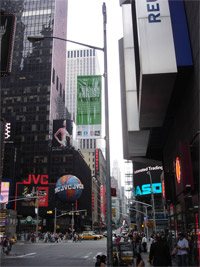
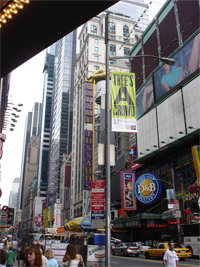
LEFT: Urban Forest introductory banner RIGHT: Banner by Armin Vit [Click on each image for bigger view, pop-up]
The project started brewing in the Fall of 2005 as a somewhat loose phone call from Worldstudio Foundation — an organization “devoted to encouraging social responsibility in the design and arts professions” — to the AIGA New York chapter with an opportunity to use 185 banners across Times Square for something, as offered by the Times Square Alliance. Yes, it was that loose. Alan Dye, board member of the AIGA New York chapter and Design Director at kate spade, along with fellow board member and untiring writer, Alice Twemlow, embarked on what seemed like a never-ending series of phone calls and meetings that eventually led to the agreement on the project and its brief: To design banners “with the form, idea or a characteristic of a tree and consider using [them] to interpret and explore an issue that [we] feel is pressing, or an idea [we] find entertaining or intriguing” with the understandable limitation that banners should not “advertise a brand or product, nor endorse a particular political party or agenda.” This was from the brief designers received as they were invited to participate. Around 70 designers were formally invited, ranging from the usual suspects — as you go through the banners you will know who they are — to the intentionally far and, perhaps, unknown. In a valiant effort to dispel the Newyorkiness of the AIGA (and the AIGA NY chapter in particular) the project committee asked for recommendations of international designers and those outside the major design hubs, with banners coming from as far away as Israel, Germany and Brazil. Another 70 or so banners were open contributions from members of the AIGA New York chapter; which ultimately contributed to the unavoidable New York centricity of the constituency. And, finally, 20-plus banners were given to the very successful AIGA NY Mentoring Program so that pairings of mentors and their students could create a banner.
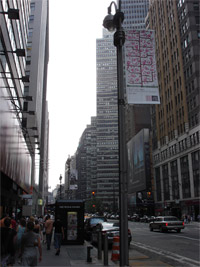
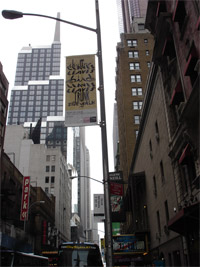
LEFT: Banner by Chip Wass RIGHT: Banner by Ed Fella [Click on each image for bigger view, pop-up]
Led by Speak Up’s own Bryony Gomez-Palacio, with the help of Soyoung Kim and Carrie Brunk along with the Mentoring Program’s Emma Pressler and Kris Angell, the students and their mentors went through a two-month process starting with a scavenger hunt aimed at forcing the students to see the surroundings of where the banners would be, followed by six formal workshops and critiques with two of those featuring guest critics and speakers Sam Potts on one occasion, and Michael Bierut another. The process squeezed the best out of the students (and their mentors) and exposed them to the design process, yielding some amazing results (like Radovan Jenko’s “poetree”) that at times are even hard to separate from the work of the professionals — this is both praise for the students and knock for the experienced designers.
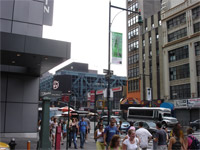
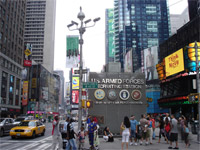
LEFT: Banner by Massimo Vignelli RIGHT: Banner by Rick Valicenti [Click on each image for bigger view, pop-up]
Without getting into a 150-plus-banner critique I’ll just say that there are banners that are amazing, banners that are disappointing, banners that are clever, banners that are confounding and banners that are plain and unmemorable. (Which, as a side note, appropriately points to the disparaging range of ability in our profession, I think). As I went through the banners I couldn’t avoid thinking how similar this project is to our own Word It, and the common criticism that some, if not most, of its inclusions are lame or expected or poorly executed with only a few that actually stand out. Well, the same goes with the Urban Forest Project, just on a slightly larger scale. Some designers, it looks, spent plenty of time developing their banner, others may have slapped it together minutes before the deadline and, in each of these two camps, some were on the spot while others missed it gloriously. And on a third, more annoying (to me, at least), camp, there were those that regurgitated existing work.
I may have to plead solitary on this stance, as some may not share my grief but, for the life of me, I can not understand why any designer — given a blank canvas with thousands of potential eyeballs on it — would choose to repeat work that they have executed in response to another brief, job or personal inclination. According to the invitation we received, we were asked to contribute because “[our] work demonstrates the formal excellence and conceptual rigor necessary to make this a truly extraordinary public art project.” I fail to see how opening an old file, formatting it to fit seven-by-three-feet, making minor modifications and submitting it constitutes “conceptual rigor”.
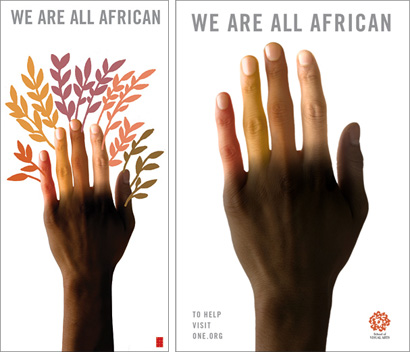
LEFT: Urban Forest banner by Milton Glaser RIGHT: Poster produced for the School of Visual Arts to help improve conditions in Africa and fight world poverty by Milton Glaser [Click image for bigger view, pop-up]
Milton Glaser contributed his year-old “We are all African” poster — already seen on phone booths around New York — with minor modifications: some sort of foliage stemming from the fingers, tighter kerning on the headline, and replacing the School of Visual Arts (who sponsored the original poster) logo with his own.
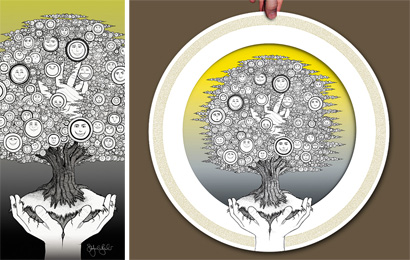
LEFT: Urban Forest banner by Stefan Bucher, 344 Design RIGHT: 2006 promotional poster “344 Questions on the Way to Wisdom” by Stefan Bucher, 344 Design [Click image for bigger view, pop-up]
Stefan Bucher, of 344 Design in Los Angeles, a designer and illustrator I admire deeply (who I hope doesn’t ice me, after reading this, when we meet again in November) submitted an amazing piece of artwork that he originally created for his yearly self-promotional poster that highlights his obsessive and unique style in the form of a tree — easily croppable into an Urban Forest banner.
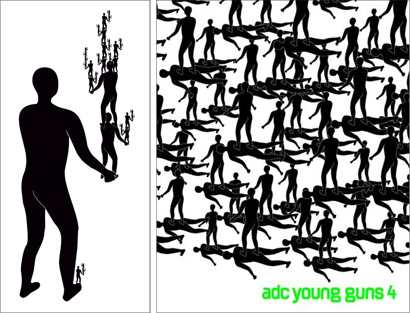
LEFT: Urban Forest banner by KarlssonWilker RIGHT: ADC Young Guns 4 book cover by KarlssonWilker [Click image for bigger view, pop-up]
New Yorkers KarlssonWilker’s banner consisted of a pyramid of their “good old friend, the standing figure” presumably in the shape of a tree — the “standing figure” was the overwhelming motif in 2005’s Art Directors Club’s Young Guns competition and is a highly recurring element in the duo’s monograph, tellmewhy.
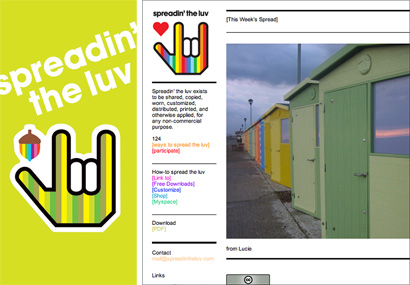
LEFT: Urban Forest banner by Greg and Paul Sahre RIGHT: “spreadin’ the luv” web site by Paul Sahre [Click image for bigger view, pop-up]
Finally, Paul Sahre’s contribution was an extension of an endeavor publicly started in January of 2006, “spreadin’ the luv”, which is based on the hand symbol for “I love You” and I assume is highly optimistic — unfortunately as someone who prefers to err on the side of cynicism and pessimism (and rarely gives anyone the benefit of the doubt) I find his contribution swimmingly self-serving. The brief suggested against endorsing a particular agenda, and while “spreadin’ the luv” is a worthy message in times like these it is Mr. Sahre’s personal agenda — the fact that his agenda is not “clubbin’ the seals” or “eatin’ the babies” perhaps makes it less opposable.
Now, some might argue that 99% of the people that will see these banners have never seen this work (much less heard of any of us) and is in turn “original” work. Fine. But we (should) know better. This is a project that publicly represents the design profession and is meant to make a stance for our originality and ability to interpret loose ideas into specific executions not our ability to rehash old ideas into redundant executions lacking originality. It also undermines the effort spent by those that created banners specifically for the project’s context. And while these duplicitous banners will have no harmful effect on the public and, like much of the design we do, it is just ephemeral and decorative, I find they are a painful misrepresentation of what designers can do. Luckily, there are a hundred other banners that make up for these.
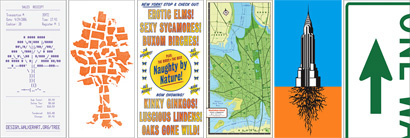
LEFT TO RIGHT: Walker Art Center, SpotCo, Douglas Riccardi, Jesse Kirsch, Rodrigo Corral, Michael Bierut [Click image for bigger view, pop-up]
From the Walker Art Center’s receipt, to SpotCo’s multi-state tree, to Douglas Riccardi’s PG-rated take on Times Square’s visual landscape, to Jesse Kirsch’s painstakingly-executed leafy Manhattan, to Rodrigo Corral’s exposé of what lies beneath the Chrysler Building, to Michael Bierut’s one way sign, and even to 2x4’s debatable “blank”, these banners (and many others) depict an acute sense of the banners’ context while providing original takes on its subjects: Trees, New York City, environmentalism, optimism and, after all, design. The project also provided an extension for some designers’ well-known styles to shine and adapt to the brief: Marian Bantjes’ infinitely connecting lines, Ed Fella’s typographic (de)arrangements, Rick Valicenti’s recent Randness, James Victore’s roughness (even though we’ve seen the high-heeled leg image before), Leif Parsons’ eerily simple figures and Michael Hodgson’s irony. These, and all, banners stand chaotically amid Times Square, dispersed from 40th to 53rd Streets and from Eighth to Sixth Avenues.
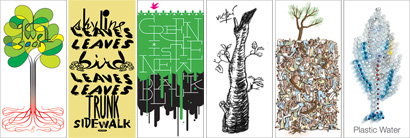
LEFT TO RIGHT: Marian Bantjes, Ed Fella, Rick Valicenti, James Victore, Leif Parson, Michael Hodgson [Click image for bigger view, pop-up]
When I first pictured the project in its setting I imagined an imposing and unavoidable presence of tree banners lining the streets but when I finally saw them in person on a cloudy day, they undeniably chameleonized into the texture of Times Square. No matter how clever the concept or how tight the typography, the banners can not stand a chance against the massive LEDs, billboards, storefronts and foot-traffic that are Times Square’s raison d’être. Those that look hard (and high) enough will be rewarded with one of the profession’s few self-initiated onslaughts of public design. And while the project might have benefited from something similar to a heavy editorial hand and a more scrutinizing selection and approval process in an effort to get the best from every participant and the profession, the Urban Forest Project stands successfully tall as an example of the interpretative and evocative powers of design as proven by more than a hundred different executions (subway maps and scent pine trees notwithstanding) on the same basic theme. Whether the public at large takes notice is still the biggest challenge but we have taken the opportunity to populate a high-profile neighborhood and, maybe unknowingly, taken the risk to ask whether design, amid the distractions of life, matters.






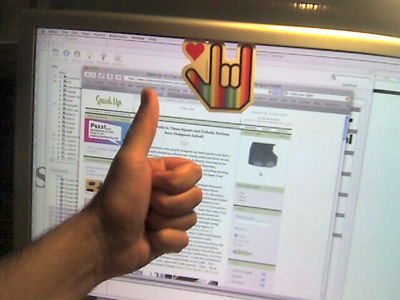
Armin,
Poignant yet balanced critique.
My thought upon seeing the site (not being in NY) was that this could be an impressive installation.
After seeing your photos and reading your words I agree that it suffers on a few levels.
SCALE, MASS or DENSITY and INFORMATION.
Seeing the banners on the site and reading that they would be 3 x 7 feet gave me a sense that they might work in the visually congested Times Square. But to see them in your photos falls short of expectation.
I am not even sure that they ended up being produced 7 feet tall judging by the scale in your images.
Further they tacked on some infographics at the bottom which are completely out of scale as they cannot be read in place. I think this image from the New York Observer is quite telling. I can read the type on the walls and billboards which are at least a block if not two away.
Even the Introductory banner's info design fails.
As you mentioned, there just are not enough of the banners to compete with the surrounding environment. Enough said.
My last complaint is this - Why oh why are they printed on what looks to be VINYL? There are times where we must print on a material such as this but this simply seems like the wrong concept to work with. Janine James of The Moderns would have been a good resource for other vinyl-like materials if a natural material could not be used.
I may be speaking out of turn here, not knowing exactly how they are produced, but this seems like an obvious error.
Armin, thanks for the insight.
- Bone
On Aug.29.2006 at 10:18 AM